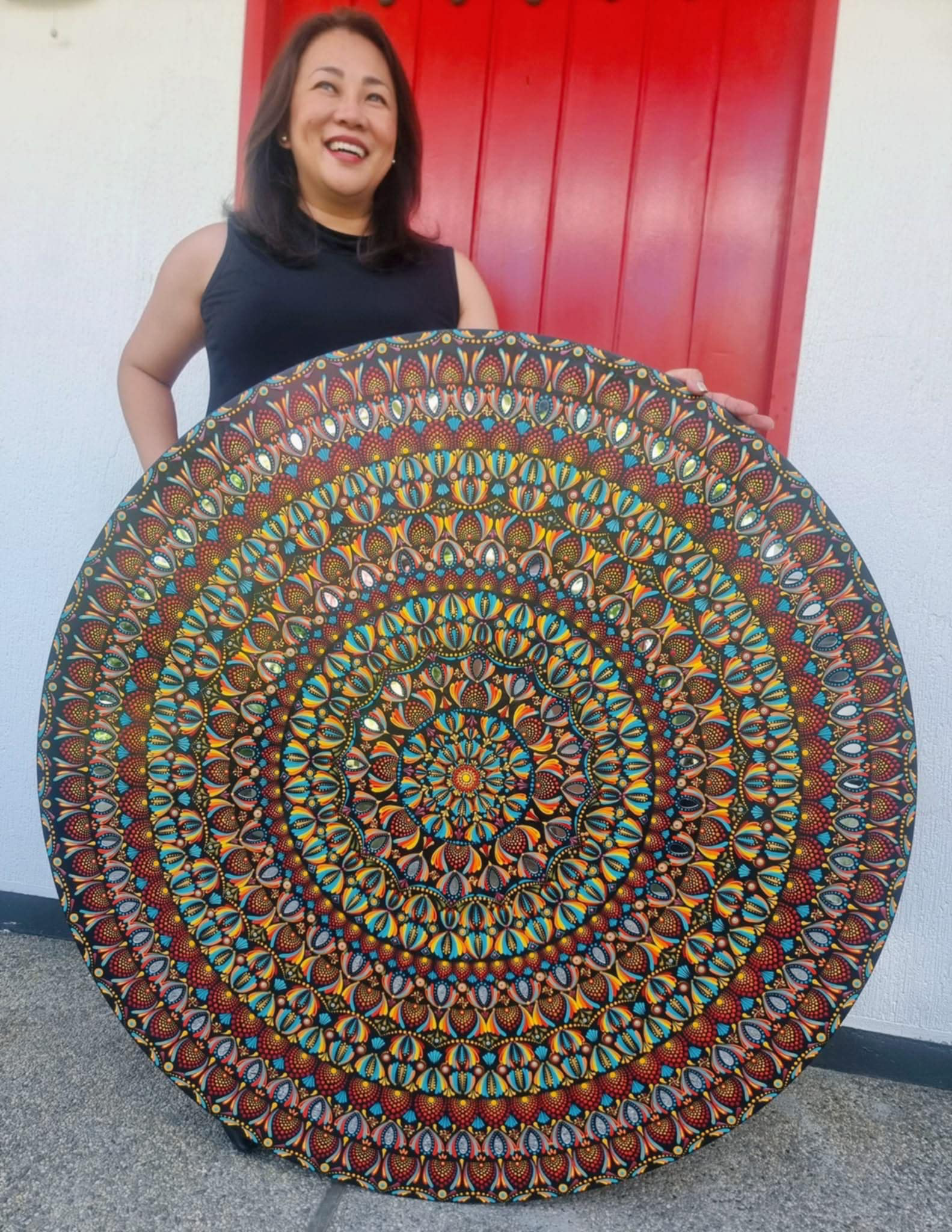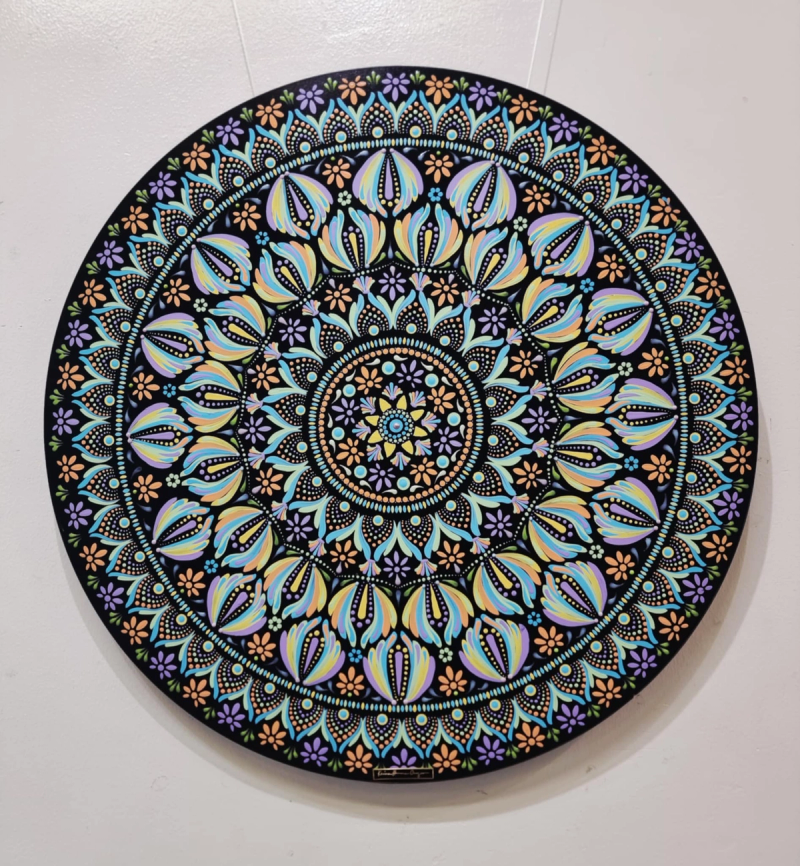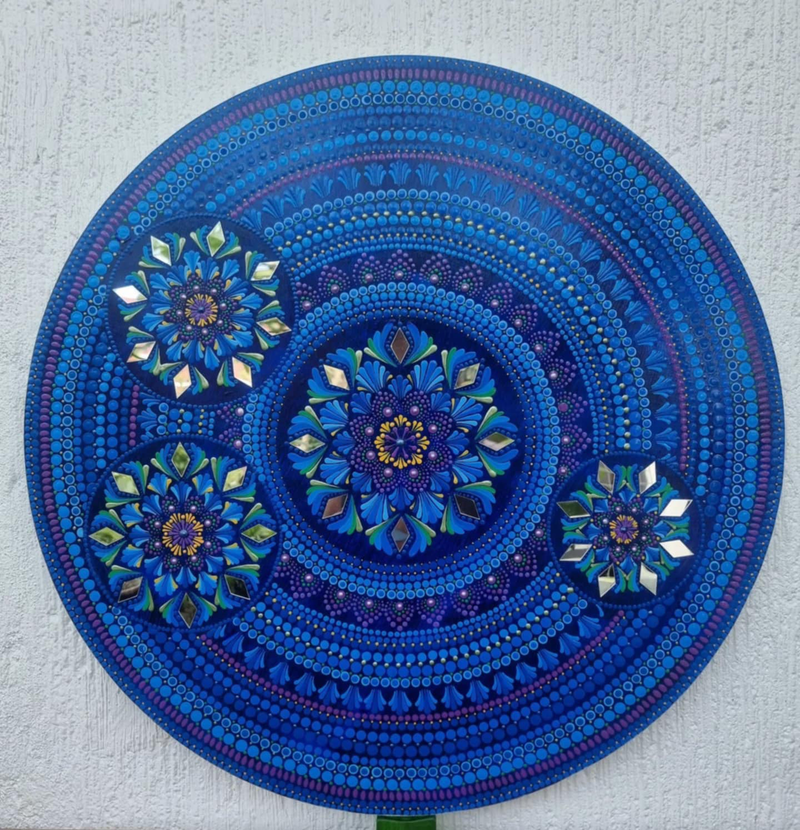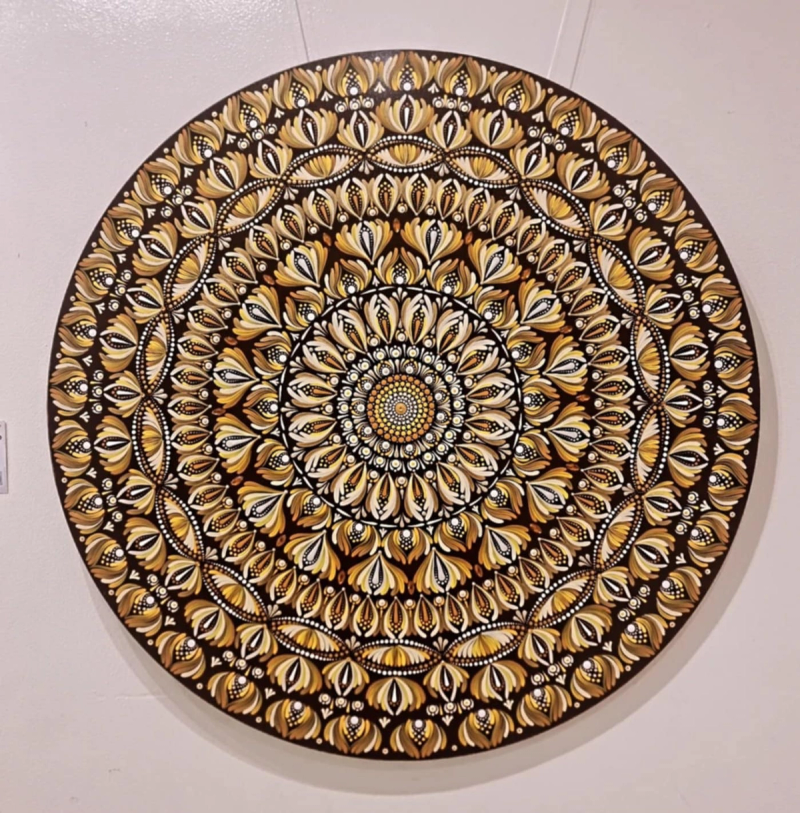Arts
Circles of Light: The Mandala Journey of Karina Herrera-Orozco

When Karina Herrera-Orozco ‘91 retired from the corporate world in 2018, she found herself with more time, time to care for her mother, time to reflect, and most importantly, time to rediscover the creative pursuits she had loved since she was young.
“Art, in different forms, is a hobby and a part of my family since childhood,” she shares. “I draw, paint, bake, cook, garden, shoot, and create crafts. Painting and drawing were my favorite pastimes during the Covid lockdown.” One day, a friend commissioned her to paint a motorcycle set against a pastoral landscape. That project unexpectedly launched her into commissioned work, setting the stage for something even more focused: mandalas.
“I’ve always been fascinated with Mediterranean tile and mandala designs,” Karina says. “It’s not a secret that many things can be learned from YouTube. I watched videos from mandala experts, learned the basic techniques and materials, and then I was on my own to create original patterns.”
Mandalas soon became more than an aesthetic interest. “My first several clients, consisting of Sigma Deltans and friends, commissioned pieces. They said they only see mandala designs commercially printed on rugs, tapestries, and ceramics from abroad. That’s when I realized mandalas could be more than a creative outlet.”

What is a Mandala, Really?
The word mandala comes from Sanskrit, meaning “circle.” But it is much more than that.
In Hindu and Buddhist traditions, mandalas are sacred diagrams, symbolic representations of the cosmos, often used in meditation and ritual. They are circular, symmetrical, and deeply symbolic, reflecting wholeness, balance, and unity. Carl Jung saw them as expressions of the self and tools for psychological integration. Indigenous cultures, too, have used circular patterns to depict spiritual maps or community order.
Today, mandalas have found their way into contemporary art, yoga, and even therapy. They are used to still the mind, calm the spirit, and express something inward and universal. In Karina’s case, they’ve become an instrument of healing and storytelling.
“Though mandala generally symbolizes inner peace and universal connection,” she explains, “I just enjoy the symmetrical patterns and repetition of elements—including the versatility of colors it exudes.”
The Rhythm of Creation
Karina’s artistic day begins with intention and serenity. “I usually start my day with a prayer, body stretches, and then have a cup of coffee as I log in Zoom with the SDPAA Global prayer group.” From there, her studio transforms into a sanctuary of light, color, and rhythm.
“I set my phone on my desk to watch movies or a podcast. Other times, I listen to music or to the news. Once settled, the creation mood starts. I usually paint until dinner, taking breaks in between to rest my eyes and body.”
The process itself is deeply meditative. “When I work on a full circle of the mandala, the dotting or brushstroke feels like a lullaby,” she says. “I call it ‘dip and dot’ when using a dotting tool, and ‘dip and swoosh’ when using a brush. That rhythm gives me delight, enjoyment, and peace.”
Some of her larger pieces can take up to 120 hours to complete. “Because of that rhythmic lullaby, I keep coming back to it. It’s a joy that doesn’t fade.”
All of Karina’s mandalas are done freehand. “There are basic elements I always incorporate, and patterns I create on my own. No artwork is exactly the same. From time to time, I step back and inspect what I’ve made before deciding what comes next.”
She adds only minimal guide marks: “I use a big compass and chalk pencil to create uniform circles. For segmentation, I use a ruler. That’s it.”
Medium and Message
Karina paints primarily with acrylic on wood—a choice driven by both form and function. “Acrylic is versatile. It dries quickly and offers a wide range of colors. Wood is durable, with a smooth surface where dots and swooshes settle nicely. It also gives the art a natural and rustic look.”
“I get a high-grade plywood from the depot and have it cut into specific circles by my carpenter,” she says. “He sands it thoroughly to smooth the surface area and the edges.”
Once the surface is ready, Karina paints a base coat. “Usually, I use black so the colors would light up,” she explains. “Other times, I use dark blue, green earth tones, off-white, or beige. I enjoy playing with colors. The mix and match is generally based on my taste and experimentation.”
While her layering technique, incorporating rhinestones, mirrors, and metallic pigments, has precedent among other artists, her interpretations are her own. One piece, for instance, evokes cherry blossoms by scattering small mandalas across a black background. “Instead of starting at the center, I placed the small mandalas randomly, to represent the flowers.”
“I plan to experiment on ceramic tiles, acrylic, canvas, and sintra board,” she shares. “These may give the mandalas a new life beyond traditional wall art—perhaps even toward functional or architectural pieces.”
Color is selected intuitively. “I have over 150 colors arranged by the color wheel. I choose based on what I fancy or haven’t used in a while. For commissioned pieces, I ask about the client’s favorite colors or the room where the painting will hang.”

Her ability to translate personal stories into visual form is especially moving. One client commissioned a piece inspired by her daughters and granddaughter, all of whom carry “Iris” as a middle name. “I made four mandala irises on the wood. The client, as the mother, was at the center—the biggest mandala. Her two daughters flanked her as smaller mandalas. The smallest represented the granddaughter.”
Emotion, Healing, and Public Connection
“In general, I am always relaxed, focused, and joyful when I paint,” Karina says. “But I also laugh, cry, and sing while working—depending on what I’m listening to. Movies, podcasts, music—they affect my emotions as I paint.”
Mandalas have also helped her through grief. “When my mother passed away in January 2024, painting became one of my outlets. It helped me stay focused, to grieve, to heal, and to reminisce the many beautiful memories I have of Mama.”
Before her solo exhibit, Karina participated in a group show held on March 7, 2025 at Corso Como, an Italian boutique shop at One Ayala Mall, Makati, owned by Millet Menguito ’94. She exhibited alongside fellow artists Ofelia Tequi ’59, Gladys Tiongco ’67, JJ Duque ’91, and Danger Sanchez ’91.
In June 2025, Karina held her first solo exhibit, Colors of Life, at Gateway Gallery. “It was a significant milestone,” she says. “This exhibition gave me the opportunity to present my mandala artworks to the public. I stayed there every day—from 10 AM to 6 PM—and personally engaged with visitors.”
The response was overwhelming.
“I received about 80 heartfelt messages in the guestbook,” she recalls. “‘Your artworks exude joy… They give rest to a weary soul.’ ‘It gives me goosebumps… hypnotizing!’ ‘Art is supposed to heal the artist and the viewer. Ms. Karina’s art does that.’ These comments gave me confidence, and reminded me that this work touches others.”
What Comes Next
“I started mandalas to satisfy the joy of creating them,” she says. “But over time, with each commissioned piece, my passion grew. My inspiration continues as my clients grow.”
As for the future? “I have some ideas in the pipeline,” Karina says with a smile. “Let me just surprise you when the time comes.”
“On my next project,” she says, “I’m thinking of creating mandalas based on Philippine festivals. It may be based on colors or incorporate a hint from the festival.”
Until then, Karina Herrera-Orozco continues to paint her way through circles of color, memory, rhythm, and light—one dot at a time.

About the Author

Javier P. Flores
A Juris Doctor from the University of the Philippines College of Law, he is a partner at the Flores & Ofrin Law Office, with expertise in corporation law, property, and litigation. Beyond the courtroom, Javi has made a name for himself as a publisher and editorial force. He is the co-owner of Milflores Publishing, a multi-awarded publishing house known for producing books that seek to elevate Filipino literature. He also founded League Magazine, a publication that spotlights the best governance practices of local leaders. Javi is also a two-time Master Photographer of the Camera Club of the Philippines. He was a former Associate Editor of the Philippine Collegian, the country’s oldest and longest-running student newspaper. Javi also served two terms on the Board of Editors for the Integrated Bar of the Philippines Law Journal.


